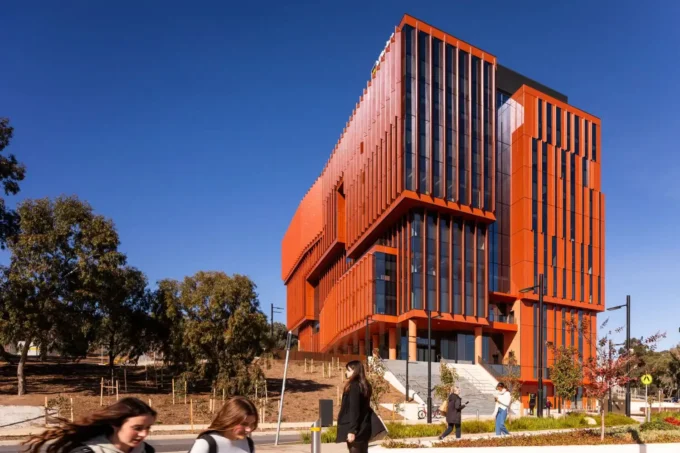The Southwest Breast and Aesthetics Medical Office, designed by Wendell Burnette Architects, is far from a conventional healthcare facility. Dedicated primarily to breast reconstruction for breast cancer patients, the clinic focuses on creating a patient experience that is deeply humane, emotionally supportive, and physically comforting. Unlike the sterile and impersonal atmosphere often associated with medical offices, this design immerses visitors in an environment defined by light, warmth, and hope.
The project addresses the sensitive and extended nature of patient care. Women arriving here have usually undergone a breast cancer diagnosis and are meeting with plastic surgeons for the second stage of their medical journey. Most patients remain under the clinic’s care for 18–24 months, often visiting with loved ones for emotional support. This long-term relationship between space and patient made it essential for the architecture to offer not only medical functionality but also psychological comfort.

Patient Journey as Architectural Narrative
At the heart of the design is a counterclockwise circulatory route—a carefully planned sequence of spaces where movement always flows toward natural light. This spatial strategy transforms the patient’s progression through the clinic into a symbolic and literal journey toward optimism and renewal. The circulation route connects consultation rooms, examination spaces, and support areas, creating a rhythm of openness and intimacy.
The architects maximized the building’s 4-meter (13-foot) interior height, allowing daylight to reach deep into the plan. Peripheral light is directed into private offices, consultation rooms, and exam areas, then further diffused through 5-foot-high glass clerestories into the main circulation corridor. This layering of light reinforces the sense of openness while preserving privacy.
Acoustic and Visual Comfort
In a healthcare setting where delicate conversations are routine, acoustic privacy was a priority. The design integrates ¼-inch steel plate at an 8-foot-high datum encircling private spaces, paired with canted glass clerestories that reduce reverberation. This careful acoustic treatment ensures clarity of speech in both public and private areas, while maintaining a calm atmosphere free from intrusive noise.
A floating acoustic curtain provides visual and functional separation between the spaces for first-time consultations and follow-up visits. This element subtly directs new patients and their support groups toward a private corner consultation room, where they can meet with doctors in a secure, secluded environment. The zoning of spaces helps reduce anxiety, allowing each patient’s experience to feel personalized and respectful.

Materiality and Light as Healing Tools
The design embraces a white, neutral palette, chosen not for sterility but for its ability to reflect and transform with the changing qualities of daylight. Natural light is treated as an active design element—its tones shifting throughout the day, mirrored in both the architectural surfaces and the furnishings.
A curated art program, along with soft acoustic furnishings and sculptural ceiling lamps, introduces moments of color and texture against the white backdrop. The combination of hard and soft materials enhances the sensory experience, balancing precision with comfort.
One of the most distinctive interior gestures is the black silk robe provided to female patients. This garment is more than functional—it becomes a symbolic and graphic element within the design. The robe’s silhouette is echoed in the custom graphics applied to the doors, subtly integrating the patient’s identity into the architecture.
Spatial Organization and Support Functions
The central core of the clinic houses support spaces, anchored by an entry wall of light that greets visitors with a luminous, uplifting presence. Administrative zones and medical preparation areas are tucked discreetly into this core, allowing the patient-facing spaces to remain uncluttered and serene.
By placing the more utilitarian functions in the center, the periphery is left free for patient areas that benefit from daylight and exterior views. This strategic distribution ensures that every patient interaction happens in an environment connected to natural light—a subtle yet powerful contributor to emotional well-being.

A Space Designed for Emotional Healing
Every architectural choice in the Southwest Breast and Aesthetics Medical Office reflects an understanding of the emotional dimension of medical care. The building’s spatial flow encourages a sense of forward movement, the acoustics foster trust and confidentiality, and the interplay of light and materiality creates a reassuring environment.
Instead of being a transitional or purely functional space, the clinic becomes a continuum of care—a place where architecture supports not just the medical journey but also the personal resilience of its patients. Here, design serves as a partner in healing, turning each visit into a reaffirmation of life, dignity, and hope.
Photography: Bill Timmerman & Jason Roehner
- Acoustic privacy in medical facilities
- Art integration in healthcare spaces
- Breast cancer recovery clinic design
- Breast reconstruction clinic design
- Comfort-focused medical interiors
- Emotional support through architecture
- Healing architecture in healthcare
- Healthcare design for emotional well-being
- Healthcare design with daylight
- Light as a healing tool in architecture
- Medical facility circulation design
- Medical office spatial organization
- Natural light in healthcare spaces
- Neutral palette in medical design
- Patient journey architectural narrative
- Patient-centered medical office design
- Privacy-focused consultation rooms
- Southwest Breast and Aesthetics Medical Office
- Wendell Burnette Architects
- White interior design for healing























































Leave a comment